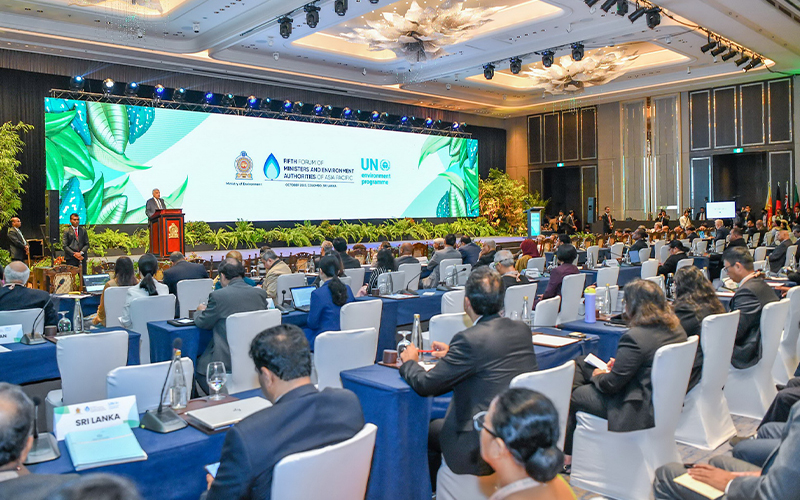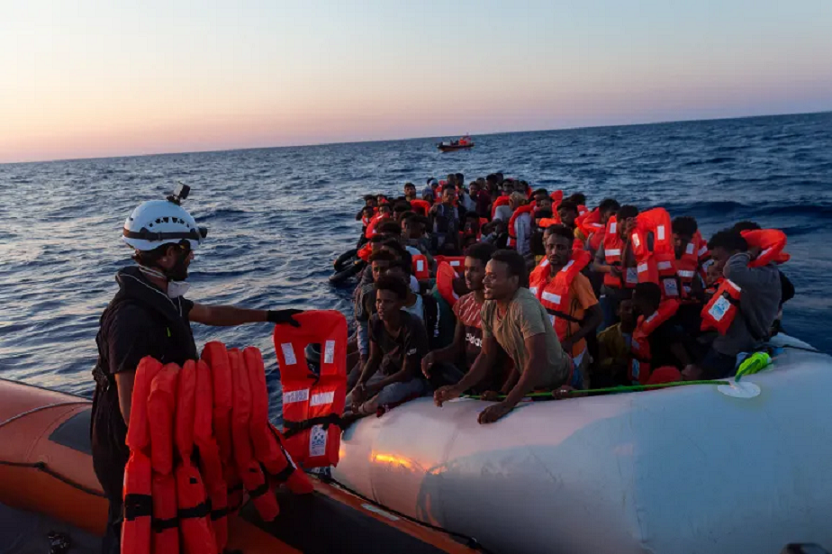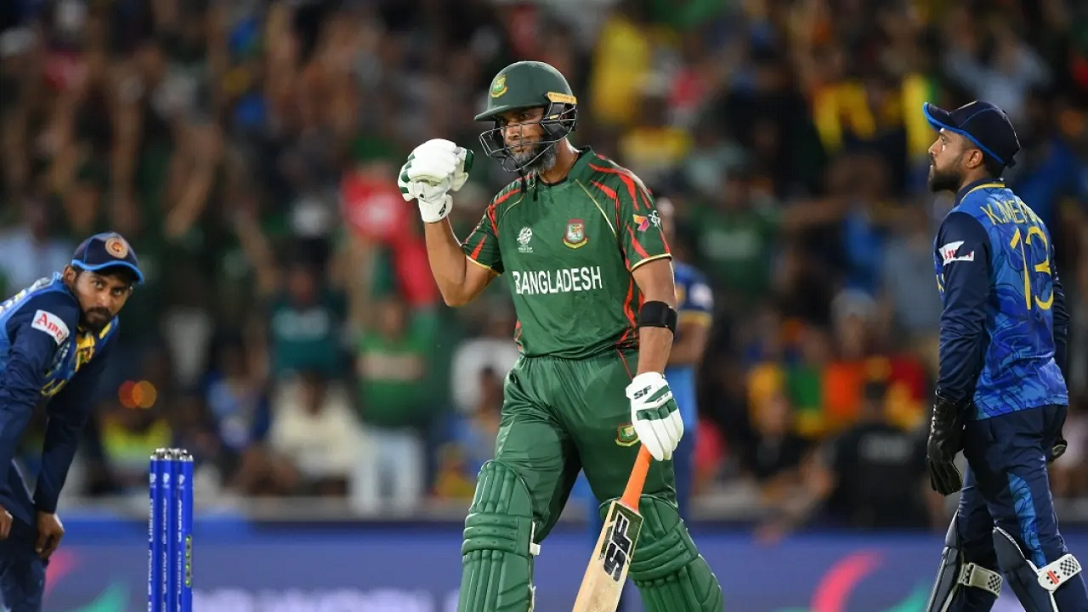Latest News
President Wickremesinghe warns of climate crisis and unveils ambitious plans

President Ranil Wickremesinghe addressed the 5th Forum of Ministers & Environment Authorities of the Asia Pacific at the Shangri La Hotel in Colombo today (05), delivering a passionate speech that emphasized three crucial points: the urgency of the climate crisis, Sri Lanka’s ambitious climate plans and the dire state of global biodiversity.
President Wickremesinghe opened his speech by drawing attention to the pressing climate concerns facing the world today. He cited the alarming estimate from the Intergovernmental Panel on Climate Change (IPCC), stating that global warming is projected to reach a dangerous 1.5 degrees Celsius between 2030 and 2052. “Humanity is facing an existential threat,” he declared. He highlighted the interlinked crises of climate change, biodiversity loss and pollution, emphasizing the devastating impact on individuals and communities worldwide.
The President then turned to Sri Lanka’s commitment to addressing these challenges. He pledged to accelerate nature-based solutions, including renewable energy, through Sri Lanka’s Climate Prosperity Plan, which was launched at COP 27. “Sri Lanka is in the process of renewing the National Biodiversity Strategic Action Plan 2016 to 2022 to achieve the objectives of the Kunming-Montreal Global Diversity Framework,” he announced. Additionally, he unveiled an ambitious Net Zero 2050 roadmap for Sri Lanka, set to be launched at COP 28.
President Wickremesinghe stressed that despite Sri Lanka’s minor global emissions contribution (0.03%), the country is dedicated to significant reductions. Sri Lanka aims to achieve a 14.5% reduction in greenhouse gas emissions by 2030, generate 70% of its electricity from renewable sources, attain a 32% forest cover, phase out coal power by 2042, and reach net-zero emissions by 2050.
The President also expressed deep concern over the state of global biodiversity. He lamented that the world has already lost 8% of known animal species, with 22% at risk of extinction due to habitat destruction and invasive species. “We are now losing biodiversity up to 10,000 times faster than it was disappearing 100 years ago,” he warned.
In conclusion, President Wickremesinghe’s speech outlined the urgent need for climate action, Sri Lanka’s commitment to sustainability and the critical biodiversity challenges the world faces. The President’s call for collective action and his unveiling of ambitious climate plans underscored the gravity of the global situation.“Countries unwilling to do their part to stop the climate crisis are guilty of committing genocide,” he concluded.
Following is the full speech delivered by President Ranil Wickremesinghe at the 5th Forum of Ministers & Environment Authorities of the Asia Pacific;
“I join our Minister of Environment in welcoming you to Sri Lanka. Humanity is facing an existential threat. The interlinked and cascading effects of climate change, biodiversity loss, and pollution—the triple planetary crisis—are demanding a heavy toll on individuals, communities and threatening life on our planet. We are putting extreme pressure on the planet. The triple planetary crisis is already exceeding the planetary boundaries. The world has already lost 8% of known animal species and 22% are at risk of extinction due to the destruction of their natural habitats and the introduction of invasive species. We are now losing biodiversity up to 10,000 times faster than it was disappearing 100 years ago. Declines in nature and biodiversity at the current trajectory will undermine the progress towards 35 out of 44 targets of the SDGs related to poverty, hunger, health, weather, cities, climates, oceans and land. In terms of change, the Intergovernmental Panel on Climate Change estimates that global warming is likely to reach 1.5 degrees Celsius between 2030 and 2052.
The other day, I read a blog by a young scientist, a member of the Union of Concerned Scientists. Her name is Sanjali De Silva. This is what she said: “People of Sri Lanka feel the impact of climate change every day. Those effects are overwhelmingly caused by the self-serving command and irresponsible action of the fossil fuel industry and the nations unwilling to do their part to stop the climate paradigm. My people of Sri Lanka and my family deserve better.” I agree wholeheartedly with her. Sri Lanka, her country and mine, has constantly been placed among the top risk of extreme weather events by the Climate Risk Index annually released by German Watch. Although Sri Lanka’s emissions are globally negligible, amounting to merely 0.03%, we, in our ambitious NDCs, have set targets for 2030 to achieve a 14.5% reduction of GHG emissions, a 70% electricity generation through renewable sources, 32% forest cover, weaning off coal power by 2042 and reaching net zero by 2050.
The Climate Prosperity Plan of Sri Lanka, launched at COP 27, aims at rapid augmentation of nature-based solutions, including renewable energy. The Net Zero 2050 roadmap for Sri Lanka will be launched at COP 28. Sri Lanka is in the process of renewing the National Biodiversity Strategic Action Plan 2016 to 2022 to achieve the objectives of the Kunming-Montreal Global Diversity Framework. Since Sri Lanka is one of the 36 global biodiversity hotspots, I have instructed the Ministry of Environment to formulate a national policy on living entities to conserve pristine ecosystems. Sri Lanka has formulated the national policy on waste management, covering nine categories of general and hazardous waste. The national policy on chemical management was formulated to streamline chemical management in the country. Sri Lanka formulated the national policy on sustainable consumption and production in 2019. The Green Procurement Policy and the Green Labelling Framework will come into effect this year. My government will enact a new Climate Change Act and a National Environment Act to address the triple planetary crisis in the context of new knowledge and practices. We are starting our transition to a green economy. But there is a cost. The Climate Prosperity Plan, which spans from 2023 to 2042, will require 26.5 billion U.S. dollars. The implementation of the Net Zero 2050 roadmap will require over 100 billion U.S. dollars. The list is not over. Where are we going to source these resources from? We cannot source all this money from within our country. The problem is not confined to Sri Lanka.
Developing countries require financing up to 5.9 trillion U.S. dollars to fulfill their NDCs up to 2030. A further 4 trillion U.S. dollars is required per annum for clean energy technology to achieve net zero emissions by 2050. At COP 27, there was an agreement to provide the lost and damaged funding for vulnerable countries hit by climate disaster. The Sharm El Sheikh Implementation Plan, a transitional committee was established. The meetings of the committee and the discussions at the recent sessions of the UN during the UN General Assembly have not resolved key questions.
a. Who will contribute? Is it the developed nations? EU, UK, Norway, among others, say all countries are liable to pay.
b. The question of criteria. Who will receive the funds?
c. Where to house the fund? At the World Bank or UNFCC?
d. Where do you find the money for the fund? Is it re-channelling existing funds or new additional funds? Delegates, these discussions are getting nowhere and it’s unlikely that these issues will be resolved by the time of COP 28.
The ability of global leaders to cooperate and provide a coordinated response to existential challenges such as climate change is missing in a scenario dominated by great power rivalries, geopolitical interests and in many cases domestic policy. For instance, it is not feasible to expect robust leadership of the United States in the global fight against climate change next year. The US will be caught up in an acrimonious election year and must first overcome domestic debates between climate deniers and those who are serious about addressing the issue. The Ukraine war will tie down Europe. The Indo-Pacific will witness further escalation of tension. Numerous global fora have attempted to address the issue of climate change. The Bridgetown Initiative, Paris Pact for People and Planet, and numerous initiatives by the UN Secretary-General. The issues and potential solutions have been well articulated at these events. What is missing is the money on the table, leadership and action.
Therefore, we in Asia-Pacific and others in the global south will need to galvanize an alternative leadership mechanism. What is crucial is that geopolitics and great power rivalries take a second place when it comes to addressing climate issues such as climate change and global environmental degradation. We need a climate justice forum to ensure that the countries least responsible for climate change do not bear a disproportionate share of the loss. We need to raise our collective voice and say, let’s get done with this. While the debate on the loss and damage fund continues, we should insist on the following: The money on the table is negligible, but let’s at least start with the 100 billion SDI initiatives available to the IMF and convert that into actions and positive outcomes. The developed economies should be held accountable for meeting their net zero targets at least by 2040. If they fail to stay in line with these targets, such countries should be required to compensate the rest of the world. These funds can help with the financing requirements for climate mitigation, adaptation and climate prosperity of developing nations. The global ambitions regarding finance of combating climate change have so far been woefully inadequate. It is also not just public funds that can resolve the magnitude of the issue at hand.
The Bridgetown initiative has clearly articulated the need for using the balance sheets of the NDBs to provide guarantees and leverage private funds to be channelled towards addressing climate change issues in developing nations. Additional volumes of concessionary financing at scale through the NDB are also a crucial requirement. Climate-related investments provide long-term returns, which cannot be financed by fragmented short-term high-cost private financing. The prevailing situation where global monetary tightening is pushing up market-linked lending rates of NDBs and the IMF is also an opportune moment to consider options of capping such rates or other means to avoid further fiscal burdens on borrowing nations. All three initiatives above would have been on the agenda in a serious manner long time ago had there been a greater voice of developing nations and the global south in the decision-making authorities of these global financial institutions. We must also press ahead with Kenya’s call for debt relief for low-income countries.
Parallel to these settings, we must finalize the loss and damage funds. In my view, all developed countries must contribute to the fund. We must also call for voluntary contributions by the developing countries, especially those exceeding the 2050 target. The Vanuatu Resolution has taken the issue of climate change before the International Court of Justice. This is the start of a process of recognizing climate justice as a human right. It is the core of the right to life. All other rights flow from the right to life. Countries unwilling to do their part to stop the climate crisis are guilty of committing genocide.”
Latest News
‘Bloody policies’: MSF recovers 11 bodies from Mediterranean off Libya

The aid group Doctors Without Borders has reported recovering 11 bodies and rescuing dozens of people off the coast of Libya as it criticised the migration policies of the North African country and European countries.
In a statement on Friday, the group, known by its French initials MSF, said its Geo Barents rescue vessel managed to recover the bodies following a search operation lasting more than nine hours after being alerted by German nongovernmental organisation Sea-Watch, which also rescues refugees and migrants.
“As we cannot determine the reason behind this tragedy, we know that people will continue to take dangerous routes in a desperate attempt to reach safety, and Europe must find safe and legal pathways for them,” MSF said in a post on X. “This catastrophe must end!”
Sea-Watch said it is unclear whether the bodies were victims of a previously unknown shipwreck, adding that they tried to contact Libya’s coastguard to go and retrieve the dead, but received no reply.
“The so-called Libyan coastguard – financed by the EU – ignored our call demanding that the bodies be recovered,” the group said.
Thousands of people trying to head from Africa to Europe use Libya as a departing point, with the Italian island of Lampedusa the nearest European destination as they undertake the dangerous journey across the Mediterranean to escape war, poverty and persecution.
Italy, which wants to put a stop to the migration stream, has said Libya and neighbouring Tunisia must do more to stop people from going to sea. It has also clamped down on the operation of the rescue ships, arguing that they encourage people to head to Europe, a charge that is denied by the charities.
Emphasising its policy on the rescue ships, Italy said on Friday that it forced the MSF rescue vessel to take the 165 people that it had saved from boats in the Mediterranean operation to the northern port of Genoa. The port was more than 650 nautical miles (1,200km) from their position and much farther than the more convenient ports in nearby Sicily, significantly delaying assistance to the rescued.
The route in the central Mediterranean is the most dangerous migrant crossing in the world, with the United Nations registering more than 20,000 deaths and disappearances in the area since 2014.
More than 3,000 refugees and migrants went missing in 2023 while attempting to use the route, according to the International Organization for Migration.
According to Italy’s interior ministry, the number of arrivals in the country has dropped in 2024 to fewer than 21,800 people since the beginning of the year, compared with close to 53,300 in the same period last year.
[Aljazeera]
Latest News
Mustafizur, Rishad, Hridoy dazzle in Bangladesh’s tight two-wicket win over Sri Lanka

Nuwan Thushara’s last over brought Sri Lanka screaming back into the match,as he first bowled Rishad Hossain, and then nailed Taskin Ahmed in front of the stumps with a pinpoint swinging yorker. This left Bangladesh eight wickets down, with 12 runs still to get.
However, the experienced Mahmudullah was at the crease for Bangladesh, and despite some further nervy moments, pushed Bangladesh across the line off the last ball of the 19th over.
But this was a match chiefly decided by Bangladesh’s own outstanding bowling. Mustafizur Rahman was the best among them, using shorter lengths and his cutters efficiently, to claim figures of 3 for 17. Rishad Hossain’s three-for through the middle overs also kept Sri Lanka quiet.
Mustafizur was instrumental in Sri Lanka’s downward spiral through the middle overs, which culminated in a crash-and-burn end. Ultimately, their inability to find boundaries, or even rotate strike against good Bangladesh bowling resulted in their downfall. A score of 125 for 9 always seemed poor on a decent pitch, even if their bowlers made a match of it in the end.
Brief scores:
Bangladesh 125 for 8 in 19 overs (Towhid Hridoy 40, Litton Das 36; Dhanajaya de Silva 1-11, Nuwan Thushara 4-18, Wanidu Hasaranga 2-32, Matheesha Pathirana 1-27) beat Sri Lanka124 for 9 in 20 overs (Pathum Nissanka 47, Dhananjaya de Silva 21; Tanzim Hasan Sakib 1-24, Taskin Ahmed 2-25, Mustafizur Rahman 3-17, Rishad Hossain 3-22) by two wickets
[Cricinfo]
Latest News
Rashid, Farooqi and Gurbaz the stars as Afghanistan crush New Zealand

Afghanistan boosted their Super Eight chances with yet another dominating win, this time thumping New Zealand by 84 runs in Providence. Having beaten Uganda by 125 runs in their opening match, they are now at the top of Group C with a net run rate of 5.225.
After being sent in, Rahmanullah Gurbaz and Ibrahim Zadran gave Afghanistan a start of 103 in 14.3 overs. It came off the back of the 154 the pair added against Uganda, thus making them the first opening pair to register two successive century stands in the history of the T20 World Cup.
Afghanistan’s was an innings of two halves. They scored 55 for no loss in the first ten overs and 104 for 6 in the last ten, with Gurbaz contributing 80 off 56 balls. New Zealand, who had decided not to play any warm-up games, looked every bit rusty as their fielders dropped catches and missed run-out opportunities.
With the pitch assisting both seamers and spinners, chasing 160 was not going to be easy. But few would have expected New Zealand to collapse in the manner they did.
Fazalhaq Farooqi picked up three wickets in the powerplay and Rashid Khan three just after it. Eventually, both ended with identical figures of 4 for 17 as New Zealand were bowled out for 75 in the 15.2 overs. Glenn Phillips and Matt Henry were the only New Zealand batters to reach the double digits.
Trent Boult found some swing in the opening over but Gurbaz and Ibrahim showed their intent by picking up three fours off Henry from the other end. Both batters had luck on their side, too. Gurbaz got a second life when he skipped down the track to Santner and missed the ball, which went on to brush the leg stump but the bails did not budge. In the following over, Finn Allen dropped Ibrahim off Henry at the deep-square-leg boundary.
That was not all. Gurbaz got another reprieve after being involved in a miscommunication with Ibrahim. Having taken off for a single, Gurbaz had to retrace his steps and would have been run out had Conway not fumbled the throw.
Two balls later, New Zealand finally seemed to have found success when Santner pinged Ibrahim’s pads and umpire Kumar Dharmasena ruled it lbw. But the batter got the decision overturned on review as the ball was heading down the leg side. Immediately after that, Ibrahim hit Santner for an inside-out four as Afghanistan ended the powerplay on 44 for no loss.
New Zealand went against the prevailing wisdom of not bowling an offspinner when two right-hand batters at the crease, and Michael Bracewell repaid that faith by conceding only six off his first two overs.
Lockie Ferguson was even more frugal, going for five in his first two. He could have had Ibrahim off a slower full toss but a leaping Kane Williamson failed to pull off a one-handed stunner at mid-off. That meant while Afghanistan remained unscathed, they had only 55 on the board after ten overs.
Afghanistan had not hit a single six in the first ten overs, but there were five in the next three, including three in one Bracewell over as Gurbaz and Bracewell stepped on the accelerator. The pair took the side past 100 in the 14th over. New Zealand finally broke through when Ibrahim bottom-edged a short ball from Henry onto his stumps, after having been hit on the grille on the previous delivery.
Promoted to No. 3, Azmatullah Omarzai played his part with 22 off 13, which included two sixes in three balls off Henry. Mohammad Nabi fell for a first-ball duck but Gurbaz kept finding the boundary at regular intervals. However, a three-wicket, three-run final over by Boult kept Afghanistan to 159.
Farooqi gave Afghanistan a dream start with the ball. With the very first delivery of the innings, he uprooted Finn Allen’s leg stump as the ball moved in late. In the seamer’s next over, Conway pushed at one that seemed to come slower off the surface and was caught at extra cover.
The decision to give Farooqi a third over in the powerplay brought further rewards. This time, bowling around the wicket to Daryl Mitchell, he got a length delivery to just straighten and take the outside edge. Gurbaz took a regulation catch to complete the dismissal and leave New Zealand 28 for 3.
It could have been worse for New Zealand. In between, Naveen-ul-Haq had rapped Kane Williamson’s front pad after the batter had moved across to play a delivery. Afghanistan sent it upstairs for an lbw review but the umpire’s call saved the New Zealand captain.
Afghanistan did not have to wait too long for Williamson’s wicket. Rashid brought himself on after the powerplay and struck straightaway as Williamson guided one to first slip. But Rashid was just warming up. In his next over, he dismissed Mark Chapman and Bracewell off successive deliveries to leave New Zealand on 43 for 6. Chapman went for a pull and got bowled; Bracewell was late to bring his bat down and was lbw.
Phillips was New Zealand’s last hope. He did hit a couple of boundaries but was soon caught at long-on when he tried to take on Nabi. That ended any hopes of revival New Zealand might have had.
Brief scores:
Afghanistan 159 for 6 in 20 overs (Rahmanullah Gurbaz 80, Ibrahim Zadran 44, Azmatullah Omarzai 22; Trent Boult 2-22, Matt Henry 2-37, Lockie Fergusoan 1-28) beat New Zealand 75 in 15.2 overs (Glenn Phillips 18; Rashid Khan 4 for 17, Fazalhaq Farooqi 4 for 17, Mohammad Nabi 2-16) by 84 runs
[Cricinfo]












